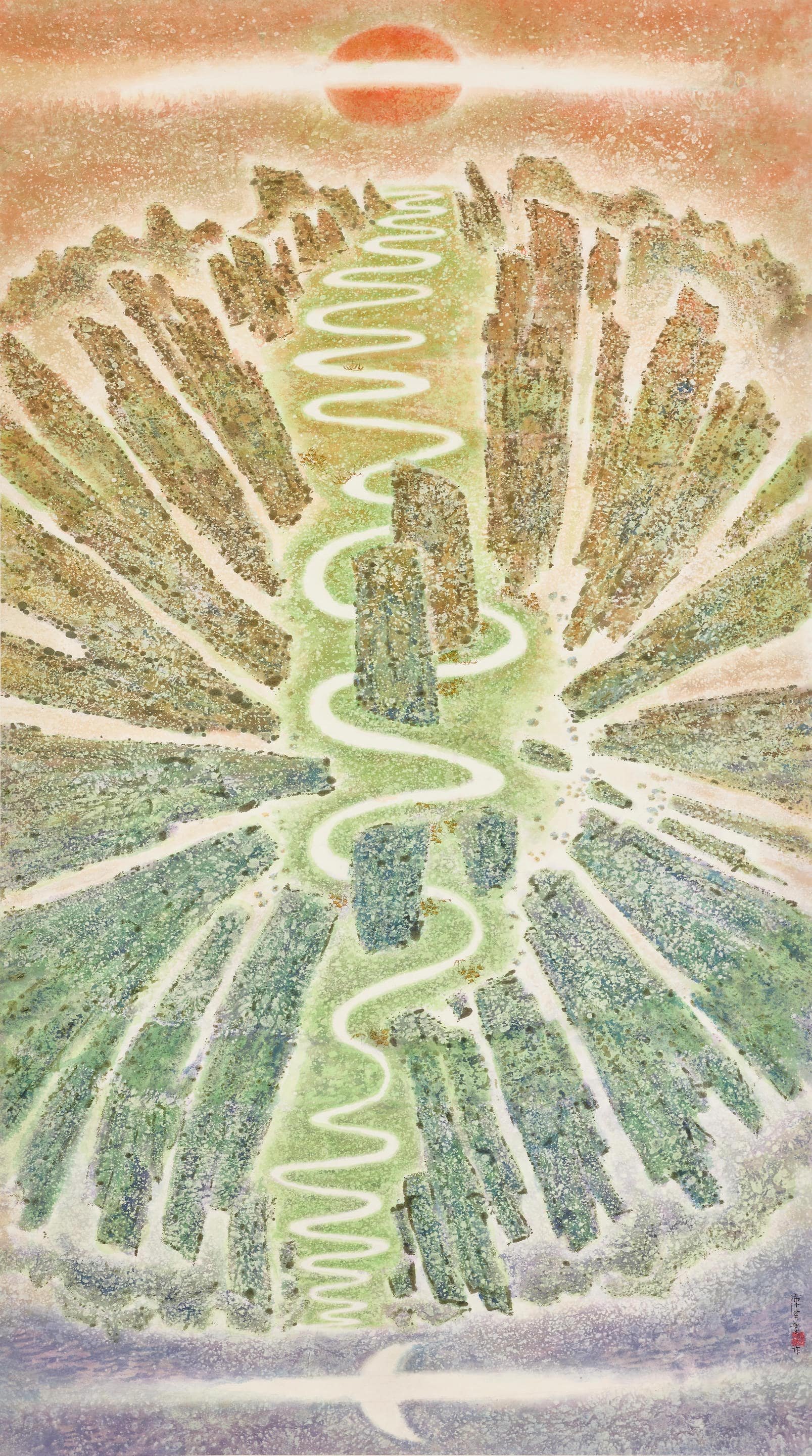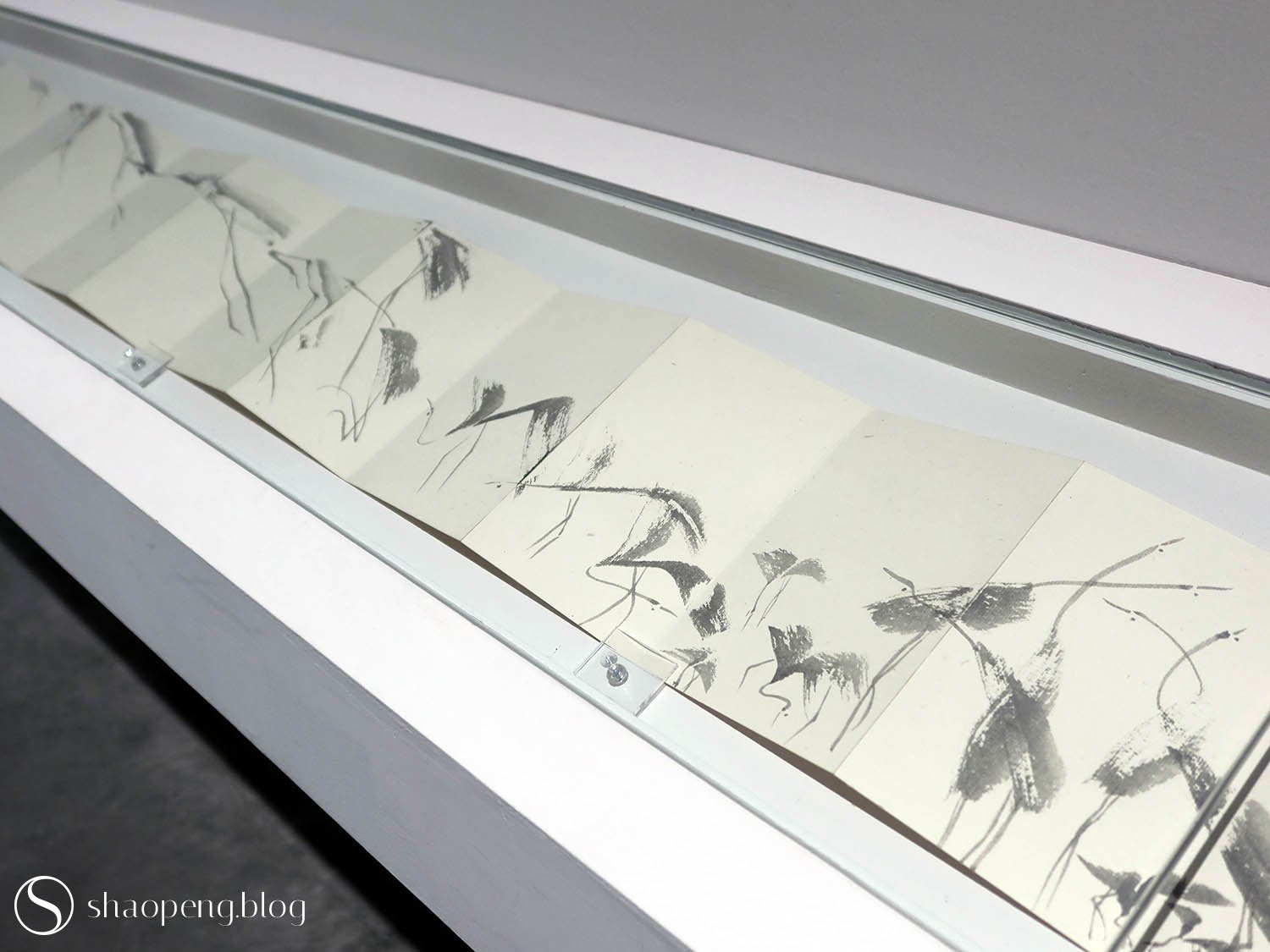Poetry in Motion: The Floating World of Chen Chih-Kwan
As both an artist and architect, Chen Chih-Kwan’s ink paintings invite viewers into a mesmerising experience — one where they are no longer bound by a single perspective but are free to wander through a fluid, ever-changing landscape within the artist’s imaginative world.
Sense of Wander: ★★★★★
The idea of floating perspective adopted by Chen Chih-Kwan in Noon (1969) sets him apart from his contemporaries.
TAINAN, Taiwan — Today, the way we perceive art, especially painting, is largely shaped by the concept of perspective, an invention of the Italian Renaissance.
The development of linear perspective, pioneered by artists like Filippo Brunelleschi (1337-1446) and Leon Battista Alberti (1404-1472), sparked a revolution in Western painting. By introducing the illusion of depth through vanishing points, artists unlocked a new way to depict three-dimension space on a two-dimensional surface, offering a more “realistic” representation of the world.
In the 16th and 17th centuries, this Western technique made its way into China, primarily through interactions with Jesuit missionaries such as Matteo Ricci (1552-1610) and Giuseppe Castiglione (1688-1766). The Chinese approach to composition and viewer engagement began to evolve in response to these new ideas.
But long before Western influence arrived, Chinese artists had already cultivated a fluid, distinctive way of depicting space. Guo Xi (c. 1020–1085), a master landscape painter of the Northern Song dynasty (960–1127), introduced the concept of “floating perspective.”
Unlike the fixed viewpoint of linear perspective, Guo Xi’s technique offered multiple vantage points within a single composition, creating a dynamic and immersive experience. His method invited viewers to journey through the scenery, floating around it and discovering new details from different angles.
While floating perspective became a cornerstone of Chinese art, it isn’t as prominent in contemporary Chinese painting today. Yet few artists have embraced and interpreted it as compellingly as Chen Chih-Kwan (1921–2007). Unlike many of his contemporaries who adopted Western techniques, Chen stayed true to the Chinese ideals, allowing the fluid and dynamic nature of floating perspective to guide his compositions and his viewers.
In Torso (1979), Chen Chih-Kwan employs a minimalist approach to capture a mosquito that is about to feed on a person’s skin.
Chance (1980) by Chen Chih-Kwan captures a whimsical scene of roosters and chicks gathered in a cluster, their attention focused on a mosquito fluttering above them.
Though I’ve admired Chen Chi-Kwan’s work for nearly a decade — falling in love with his art when I first saw postcards of his work at the Taipei Fine Arts Museum — I only had the chance to experience his work in person this summer. The exhibition Chen Chi-Kwan: A Duet — Art and Architecture, held by the Tainan Art Museum to celebrate the artist’s 103rd anniversary, provided that long-awaited opportunity.
As its title suggests, the exhibition celebrates Chen Chih-Kwan’s remarkable achievements in both art and architecture. In this article, I will focus on his paintings, highlighting how architectural elements and his unique use of space are prominently reflected in his work. As Chen himself stated in an interview, if given the choice between art and architecture, he would undoubtedly choose the former.
My initial encounter with Chen’s art was through his whimsical depictions of monkeys in embrace, roosters gathered in lively clusters, and crabs scuttling with character.
His minimalist brushstrokes, inspired by the 13th-century Buddhist monk and painter Muxi, capture the essence of nature and fleeting moments with remarkable simplicity. Yet Chen’s contribution to the art world extends far beyond these playful representations.
Trained as an architect, Chen Chih-Kwan has influenced modern Chinese art with his unique approach to painting. By expanding on the concept of floating perspective, he challenges conventional viewpoints and introduces an even more liberated and dynamic approach to space and form.
Imagine a painting that depicts a landscape from afar. As you move closer, the scene transforms into a tapestry of tiny, intricate details — minuscule houses, boats, and figures spring to life. This play of scale and distance is beautifully exemplified in Noon, where a radiant sun shines at the centre of a square canvas, drawing viewers into a magical journey.
A closer look at Chen Chih-Kwan’s Noon (1969) reveals the artist’s masterful manipulation of scale. By rendering figures so small that they are barely visible to the naked eye, he captures the grandeur and vastness of nature.
Standing before Noon (午), you’ll see tall, lush mountains rising from all four sides of the canvas. It quickly becomes clear that you’re viewing the scene from a worm’s eye perspective. As you move closer, tiny figures in red and blue emerge, making their way up to the temple at the summit. These details become apparent only up close, with some requiring you to tilt your head sideways to fully appreciate the scenes unfolding across different part of the landscape.
Stand back for a moment, and the painting seems to invite you to shift your perspective to a bird’s eye view, adding another layer of depth. This interplay of viewpoints expands on Guo Xi’s “Three Distances,” offering a dynamic and immersive experience. It invites viewers to traverse the painting as if they were navigating a boundless landscape, transcending the limits of their physical bodies.
Chen’s use of floating perspective is epitomised in Landscape with Sun and Moon (日月光華), a hanging scroll that offers a breathtaking bird’s-eye view of Earth, with both the sun and the moon in sight. This celestial perspective evokes the sense of boundless space found in Liu Guosong’s space series, capturing the awe-inspiring vastness of the cosmos.
Landscape with Sun and Moon epitomizes Chen Chih-Kwan’s use of floating perspective.
This painting exemplifies Chen Chih-Kwan’s “Mind’s Eye” (心眼) theory, inspired by his first experience flying in an airplane. Observing the landscape shift and transform from above as the aircraft navigated through the sky, Chen was struck by the dynamic view, much like a living painting.
Drawing from this experience, he experimented with flipping his landscape upside down — a groundbreaking technique in traditional Chinese painting. This innovative approach incorporates the elements of “time” and “movement,” reflecting new perspectives made possible by modern aviation. By integrating various viewpoints, Chen creates a complex, dreamlike scene that offers an imaginative journey for both the mind and eyes.
When unfolding The Returning Cranes, the various depictions of cranes form a continuous sequence of a crane taking flight.
Chen Chih-Kwan’s seemingly effortless use of ink captures the feathered form of a standing crane with just a few strokes.
In The Returning Cranes (放鶴圖), Chen Chih-Kwan depicts cranes in various postures. When viewed as a whole, the folding album reveals a continuous sequence that captures the cranes’ graceful ascent, much like a flipbook where movement emerges from successive images. Though the entire album is visible at once, let’s not forget that the traditional practice of unfolding it section by section would have provided a completely different viewing experience, allowing the viewer to adjust the speed of the flight according to their own pace.
The depiction of the cranes in The Returning Cranes, rendered with a simple wash of ink, contrasts sharply with another of Chen’s work, Fatal 1, which also features a crane. In Fatal 1 (大劫難逃), however, the crane’s body is more stylised — defined by bold, sweeping strokes. The playful contrast is heightened by the crane’s downward gaze at a much smaller grasshopper scurrying away beneath it.
In Labyrinth, Chen Chih-Kwan skillfully integrates architectural motifs into the composition, adding a sense of depth to what would otherwise be a flat painting.
An architect by profession, Chen skillfully integrates architectural motifs like windows and doors into his paintings. In traditional Chinese architecture, these elements do more than serve functional purposes — they create a sense of depth within a complex, a quality Chen harnesses as symbolic imagery in his art, guiding the viewer’s gaze through layers of space.
One example is Labyrinth (迷宮), one of my favourite pieces from the exhibition. In this painting, a lotus flower and leaves rise from a glass bowl filled with water, with stems extending from the lotus roots below. The scene is set against a moon gate — a circular opening in a garden wall typical of Chinese gardens. Together with the apple-green parrot perched on the border of the moon gate, we’re offered a breathtaking view of a lake, mountains, sun, and boats beyond. By incorporating this architectural feature, Chen introduces depth to what might otherwise be a confined depiction of an interior setting.
In Faith, what initially appears to be a painting of terraced rice fields veiled by misty clouds reveals itself as a depiction of the Buddha in a nirvana pose, artfully blurring the line between landscape and figure painting.
By blending tradition with modernity, Chen Chih-Kwan has inspired generations of artists and become a pivotal figure in the evolution of contemporary Chinese art. His ambition to set himself apart from his contemporaries through his unique artistic expressions is evident in his own words:
To attempt to see what no one has seen before,
To think what no one has thought before,
To paint what no one has painted before,
To create what no one has created before.
Reluctant to give up the Chinese brush, paper, and ink,
Painting space, time, yet unable to avoid the human world.
Chen’s relentless quest for new perspectives has reshaped our view of the familiar, adding a refreshing dimension. In particular, his use of floating perspective invites us into a realm where viewpoints shift and merge, infusing his art with a poetic quality. Through Chen’s “Mind’s Eye,” we become not just observers but intrepid explorers, embarking on a journey into the artist’s imaginative world.
Chen Chi-Kwan: A Duet — Art and Architecture exhibition at the Tainan Art Museum.
Reference:
Ba, T. (Ed.). (2008). Chen Chi-Kwan: Architecture and Paintings. National Museum of History.
Chen Chi-Kwan: A Duet — Art and Architecture is on view at the Tainan Art Museum Building 2 in Tainan city until September 22, 2024










